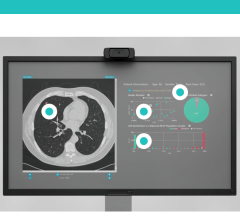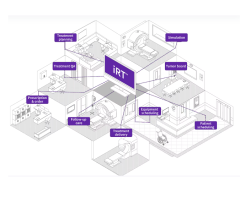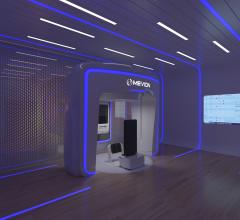
Iridium Cancer Network
Iridium Cancer Network consists of all seven hospitals in the Antwerp region, closely collaborating regarding radiation oncology. The network acts as a single radiation therapy department, making it the largest in Belgium with its annual 5,300 patients. Iridium was first to use the RayCare* oncology information system (OIS) clinically, only two months after it was released from RaySearch.
Iridium Cancer Network became a RaySearch customer in 2015 when choosing RayStation for its treatment planning. Iridium quickly appeared as an obvious choice of clinical partner to develop RayCare, the next-generation OIS, as the department spreads over seven hospitals. This, combined with a strong interest for clinical innovation, made the network a very attractive partner to develop aspects of RayCare related to coordinating cancer care efforts between institutions.
It made perfect sense to help RaySearch develop such an OIS, said Piet Dirix, radiation oncologist at Iridium.
“For me, the partnership with RaySearch was an absolute no-brainer. We needed to have an OIS that we could trust and that would help us tremendously with our workflow. Hearing that RaySearch was developing such an OIS and that they were actually looking for clinical partners to develop it with them, I became incredibly enthusiastic and we really wanted to participate in that,” he said.
Seamless Integration With RayStation
Iridium became a clinical partner to RaySearch in late 2015 and has since made a strong contribution to develop RayCare, especially with features that will support coordinated activities between different institutions. The first steps of the clinical use were done with a focus on planning workflow support and image management using RayPACS, a picture archiving and communication system (PACS) that makes it fast and easy to retrieve and share images.
“With RayCare, we can just label an image in RayPACS and then the system handles the import from RayPACS to RayStation. When launching RayStation, the patient information is there, your CT is there and you can start work directly with your patient. This is a big improvement,” Gert De Kerf, medical physics expert, said.
The tight integration between RayCare and RayStation simplifies the teamwork between clinicians, especially when different clinicians can be working on a single patient at different steps of the treatment process.
“Here at Iridium we work as a team to treat the patients. So, it is possible that I delineate a CT scan, that my colleague approves a plan, and another revises the adjustments that are made to the plan. In that way, RayCare is very crucial to the way we work,” said Carole Mercier, radiation oncologist.
“Before the implementation of RayCare we had some problems with commenting when a plan was rejected. Now, thanks to RayCare and the feedback loops, this is simplified,” De Kerf said.
The seamless integration between the systems is great, said Dirix.
“What I am most satisfied with is the close interaction with RayStation. When I push on a certain task in RayCare, RayStation immediately opens at the right patient, in the right time of his or her workflow. This really saves time,” he said.
After a few months of using the RayCare OIS they can already note some efficiency improvements. RayCare and RayStation are used together on one Linac at Iridium, which is actually the linac with the shortest waiting time within the network, according to Dirix.
“There are now around three days wait at the machine where we have RayCare and RayStation, compared to around 21 days at the other linacs. This shows you how powerful the combination is,”
Piet said.
Simplified Workflow
On top of the close interaction with RayStation, RayCare provides other valuable advantages. It has simplified the patient intake consultation process and reduced issues from 25 to 5 percent. RayCare’s schedule automation feature made it much simpler to find the optimal treatment date, eliminating the delays that could result from the complexity of the manual scheduling.
RayCare has been developed by RaySearch to meet the ends of the needs of diverse cancer centers to enable them to give the best possible care to their patients. Therefore, in RayCare digital workflows tailored to the clinic’s needs can be created. The workflows are designed to be highly configurable and tasks for specific staff members can be created automatically, triggered by defined events.
The workflows used at Iridium are custom made and set up in collaboration between Iridium and RaySearch. Six workflows for five tumor groups were specified to Iridium’s needs, with a focus on automation and optimization.
“On the stereotactic treatments we treat five different tumor groups and for these patients six workflows were created. They were all made to our specific needs; for example, we needed an anchor date for an MRI. RayCare now has an anchor date for the MRI,” said Mercier.
Comprehensive Cancer Care is the Future
Centers today often use multiple software systems, including systems for radiation oncology, medical oncology and surgical oncology. The aim with RayCare is to combine these into a single, harmonized system to manage the patient’s entire oncology treatment — from scheduling through treatment delivery and follow-up.
Iridium shares that same ultimate vision of a borderless oncology environment and the future results of the partnerships look very promising.
“I think the future of cancer care will be comprehensive. I think we have to break down the walls between radiation oncology, medical oncology, surgery and especially pathology. These need to be incorporated into a single OIS, and that is exactly what RayCare allows you to do,” said Dirix.
* Subject to regulatory clearance in some markets.



 December 04, 2025
December 04, 2025 









